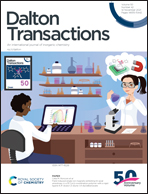A selective fluorescent probe for gadoliniumIII in water based on a PdII-preorganized chromone-receptor†
Abstract
The synthesis, solution studies, photochemical properties and the X-ray structure of a chromone based fluorescent PdII complex are reported. The ligand contains two chromone units linked as side arms to an ethylenediamine moiety; in the PdII complex the metal ion preorganizes the two hydroxychromone units forming a rigid structure with a negatively charged pocket formed by four oxygen atoms that is able to interact with hard metal cations, such as ions, giving rise to stable bimetallic complexes. Upon interaction with LaIII and GdIII, in particular, the emission intensity at 423 nm increases by a factor of 2 and 8, respectively, while the other rare earth ions quench the fluorescence. Spectrofluorimetric studies on real matrices showed the possibility to use this system as a selective fluorescence probe to detect and trace the presence of Gadolinium in environmental water acting as an OFF–ON chemosensor, with a LOD of 0.4 ppm and a LOQ of 1.2 ppm.



 Please wait while we load your content...
Please wait while we load your content...